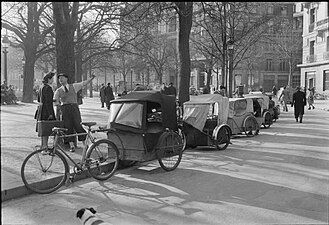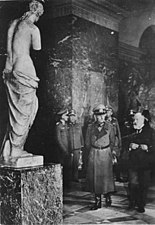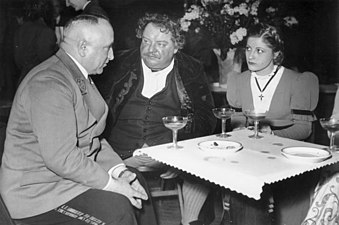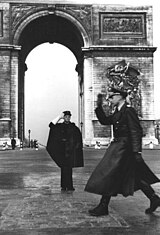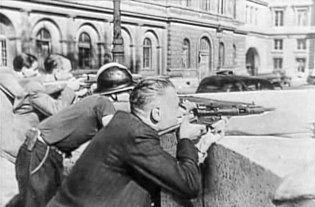Paris in World War II
This article needs additional citations for verification. (December 2022) |
| History of Paris |
|---|
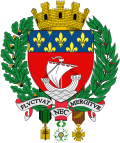 |
| See also |
|
|

Paris started mobilizing for war in September 1939, when Nazi Germany and the Soviet Union attacked Poland, but the war seemed far away until 10 May, 1940, when the Germans attacked France and quickly defeated the French army. The French government departed Paris on 10 June, and the Germans occupied the city on 14 June. During the occupation, the French government moved to Vichy, and Paris was governed by the German military and by French officials approved by the Germans. For Parisians, the occupation was a series of frustrations, shortages and humiliations. A curfew was in effect from nine in the evening until five in the morning; at night, the city went dark. Rationing of food, tobacco, coal and clothing was imposed from September 1940. Every year the supplies grew more scarce and the prices higher. A million Parisians left the city for the provinces, where there was more food and fewer Germans. The French press and radio contained only German propaganda.
Jews in Paris were forced to wear the yellow Star of David badge, and were barred from certain professions and public places. On 16–17 July 1942, 13,152 Jews, including 4,115 children, were rounded up by the French police, on orders of the Germans, and were sent to the Auschwitz concentration camp. The first demonstration against the occupation, by Paris students, took place on 11 November 1940. As the war continued, anti-German clandestine groups and networks were created, some loyal to the French Communist Party, others to General Charles de Gaulle in London. They wrote slogans on walls, organized an underground press, and sometimes attacked German officers. Reprisals by the Germans were swift and harsh.
Following the Allied invasion of Normandy on 6 June, 1944, the French Resistance in Paris launched an uprising on 19 August, seizing the police headquarters and other government buildings. The city was liberated by French and American troops on 25 August; the next day, General de Gaulle led a triumphant parade down the Champs-Élysées on 26 August, and organized a new government. In the following months, ten thousand Parisians who had collaborated with the Germans were arrested and tried, eight thousand convicted, and 116 executed. On 29 April and 13 May 1945, the first post-war municipal elections were held, in which French women voted for the first time.
Capture
-
In 1940, the French army built barricades of sandbags on some Paris streets, but they were never used (Frank Capra's film Divide and Conquer, U.S. War Department)
-
German soldiers of the 30. Infanterie-Division march on Avenue Foch on 14 June, 1940 (Bundesarchiv)
-
Adolf Hitler on the terrace of the Palais de Chaillot on 23 June, 1940. To his left is the sculptor Arno Breker, to his right, Albert Speer, his architect (Bundesarchiv)
-
German army parade on Champs Élysées in Paris, 1940. (Agfacolor)
Defense preparations
In the spring of 1939, war with Germany already seemed inevitable. In Paris, the first defense exercise took place on 2 February, 1939 and city workers began digging twenty kilometers of trenches in city squares and parks to be used for bomb shelters. On 10 March, the city began to distribute gas masks to civilians, and on 19 March, signs were posted guiding Parisians to the nearest shelters. On 23 August, Parisians were surprised to read that the German foreign minister,
Safeguarding national treasures
On 27 August, in anticipation of air raids, workmen had begun taking down the stained glass windows of the
The architectural landmarks of the city were protected by sandbags. The French Army waited in the fortifications of the Maginot Line, while in Paris ration cards for gasoline were issued, restrictions were put on the sale of meat and, in February 1940, ration cards for food were issued; however, cafés and theatres remained open.[3]
German invasion
The French defense plan was purely passive, waiting for the Germans to attack. After eight months of relative calm (known as the
French Prime Minister
Evacuation
On 8 June, the sound of distant artillery fire could be heard in the capital. Trains filled with refugees departed Gare d'Austerlitz with no announced destination. On 10 June, the French government fled Paris, first to Tours and then to Bordeaux. Thousands of Parisians followed their example, filling the roads out of the city with automobiles, tourist buses, trucks, wagons, carts, bicycles, and on foot. The slow-moving river of refugees took ten hours to cover thirty kilometers. Within a few days, the wealthier arrondissements of the city were nearly deserted, and the population of the working-class 14th arrondissement dropped from 178,000 to 49,000. [5]
Open city
The British General Staff urged the French to defend Paris street-by-street, but Pétain dismissed the idea: "To make Paris into a city of ruins will not affect the issue."
Capitulation
On the evening of 16 June, Prime Minister Reynaud resigned. On the morning of 17 June, General de Gaulle left Bordeaux by plane for London. At midday, Parisians gathered around radios heard Pétain, the new head of the French government, announce: "It is with a heavy heart that I tell you today that we must cease hostilities. The fighting must stop." Though no armistice had yet been signed, the French army stopped fighting.[citation needed]
Nazi leader Adolf Hitler arrived on 24 June for a rapid tour by car, his only visit to Paris. He was guided by the German sculptor Arno Breker and by his chief architect, Albert Speer, both of whom had lived in Paris. He saw the Opera House and viewed the Eiffel Tower from the terrace of the Palace of Chaillot, paid homage at Napoleon's tomb, and visited the artist's quarter of Montmartre.[3]
Axis occupation
-
German Luftwaffe soldiers at a Paris café, 1941 (Bundesarchiv)
-
German soldiers goose stepping at changing of the guard at the Hôtel Crillon on the Place de la Concorde, October 1940 (Bundesarchiv)
-
New signs show way to German headquarters of Greater Paris, 1940 (Bundesarchiv)
-
German soldiers in Montmartre at the Moulin Rouge (Bundesarchiv)
During the Occupation, the French Government moved to Vichy, and the
Paris became the primary destination for the rest and recreation of German soldiers. Under the slogan "Jeder einmal in Paris" ("everyone once in Paris"), each German soldier was promised one visit to Paris. One month after the beginning of the Occupation, a bi-monthly magazine and guide for visiting German soldiers Der Deutsche Wegleiter für Paris (The German Guide to Paris), was first published by the Paris Kommandantur.[9] Certain hotels and movie theaters were reserved exclusively for German soldiers. A German-language newspaper, the Pariser Zeitung (1941–1944), was also published for the soldiers. The German officers enjoyed the Ritz, Maxim's, the Coupole and other exclusive restaurants, as the exchange rate was fixed to favor the German occupiers. Many houses of prostitution existed in Paris and they began to cater to German clients.[citation needed]
The headquarters of the
Life in occupied Paris
Civilian population
By the time that the Germans arrived in Paris, two-thirds of the Parisians, particularly those in the wealthier neighborhoods, had fled to the countryside and the south of France, in what is known as the exode de 1940, the massive exodus of millions of people from the Netherlands, Belgium, Luxembourg, the north and east of France, fleeing after the German victory of the battle of Sedan (12–15 May 1940). Once the Occupation had begun, they started to return. By 7 July, the city government estimated the population had risen again to 1.5 million; it climbed to two million by 22 October, and 2.5 million by 1 January 1941. At the beginning of 1943, it fell again, because of air raids by the Allies, the arrest and deportation of Jews and foreigners, and the forced departure to factories in Germany of many young Frenchmen, as part of the Service du travail obligatoire (STO), "Obligatory Work Service".[5]
The attitude of the Parisians toward the occupiers varied greatly. Some saw the Germans as an easy source of money; others, as the Prefect of the Seine, Roger Langeron (arrested on 23 June 1940), commented, "looked at them as if they were invisible or transparent."
For the Parisians, the Occupation was a series of frustrations, shortages and humiliations. A curfew was in effect from nine in the evening until five in the morning; at night, the city went dark. Rationing of food, tobacco, coal and clothing was initiated in September 1940. Every year the supplies grew more scarce and the prices higher. The French press and radio broadcast only German propaganda.[13]
The beginning of the STO, the program that required large number of young Frenchmen to work in factories for the German war industry, in exchange for the return of older and sick French prisoners of war in Germany, greatly increased the resentment of the French population against the Germans. Most Parisians, however, only expressed their anger and frustrations in private, while the police of Paris, under German control, received every day hundreds of anonymous denunciations by Parisians against other Parisians.
Rationing and the black market


Finding food soon became the first preoccupation of the Parisians. The authorities of the German occupation transformed French industry and agriculture into a machine for serving Germany. Shipments to Germany had first priority; what was left went to Paris and the rest of France. All of the trucks manufactured at the
The rationing system also applied to clothing: leather was reserved exclusively for German army boots, and vanished completely from the market. Leather shoes were replaced by shoes made of rubber or canvas (raffia) with wooden soles. A variety of ersatz or substitute products appeared, which were not exactly what they were called: ersatz wine, coffee (made with chicory), tobacco and soap.[16]
Finding coal for heat in winter was another preoccupation. The Germans had transferred the authority over the coal mines of northern France from Paris to their military headquarters in Brussels. The priority for the coal that did arrive in Paris was for use in factories. Even with ration cards, adequate coal for heating was almost impossible to find. Supplies for normal heating needs were not restored until 1949.[15]
Paris restaurants were open but had to deal with strict regulations and shortages. Meat could only be served on certain days, and certain products, such as cream, coffee and fresh produce were extremely rare. Nonetheless, the restaurants found ways to serve their regular clients. The historian René Héron de Villefosse, who lived in Paris throughout the war, described his experience: "The great restaurants were only allowed to serve, under the fierce eye of a frequent control, noodles with water, turnips and beets, in exchange for certain number of tickets, but the hunt for a good meal continued for many food-lovers. For five hundred francs one could conquer a good pork chop, hidden under cabbage and served without the necessary tickets, along with a liter of Beaujolais and a real coffee; sometimes it was on the first floor at rue Dauphine, where you could listen to the BBC while sitting next to Picasso." [17]
The restrictions and shortage of goods led to the existence of a thriving black market. Producers and distributors of food and other scarce products set aside a portion of their goods for the black market, and used middle-men to sell them to customers. The bars of the Champs-Élysées, and other parts of Paris, became common meeting places between the middle-men and clients. Parisians bought cigarettes, meat, coffee, wine and other products which frequently neither the middle-man nor the customer had ever seen.
Transport
-
A car converted to run on coal gas instead of gasoline (1945) (Imperial War Museums, U.K.)
-
Luftwaffe officers on the Metro (Bundesarchiv)
-
Horse-drawn coaches in front of the National Assembly, decorated with slogan: "Germany is winning on all fronts" (Bundesarchiv)
-
The pedi-cab, or bicycle taxi, was still in use in the spring of 1945 (Imperial War Museums, U.K.)
Due to the shortage of fuel, the number of automobiles on the Paris streets dropped from 350,000 before the war to just under 4,500. One customer, sitting on the terrace of a café on the Place de la Bourse, counted the number of cars which passed between noon and twelve-thirty: only three came by. Older means of transportation, such as the horse-drawn fiacre came back into service. Trucks and automobiles that did circulate often used gazogene, a poor-quality fuel carried in a tank on the roof, or coal gas or methane, extracted from the Paris sewers. [18]
The metro ran, but service was frequently interrupted and the cars were overcrowded. Three thousand five hundred buses had run on the Paris streets in 1939, but only five hundred were still running in the autumn of 1940. Bicycle-taxis became popular, and their drivers charged a high tariff. Bicycles became the means of transport for many Parisians, and their price soared; a used bicycle cost a month's salary. [18]
Transportation problems did not end with the liberation of Paris; the shortage of gasoline and lack of transport continued until well after the war.
Culture and the arts
-
German field marshal Gerd von Rundstedt is given a tour of the Louvre, October 10, 1940 (Bundesarchiv)
-
The Paris Opera decorated with swastikas for a festival of German music, 1941 (Bundesarchiv)
-
After a performance of Schiller's Intrigue and Love at the Théâtre des Champs-Élysées in 1941, from left to right: Dr. Ley, Reich organization leader; Heinrich George, Schiller Theater Intendant; and German actress Gisela Uhlen (Bundesarchiv)
-
The Galerie nationale du Jeu de Paume became a storehouse for art stolen from Jewish families (TCY, 2007)
-
Vermeer's 1668 painting The Astronomerwas stolen from the Rothschild family by the Nazis and given to Adolf Hitler
One of the greatest art thefts in history took place in Paris during the Occupation, as the Nazis looted the art of Jewish collectors on a grand scale. Great masterpieces in the Louvre
Confiscations continued at banks, warehouses and private residences, with paintings, furniture, statues, clocks and jewelry accumulating at the Jeu de Paume, and filling the whole ground floor. The staff at the Jeu de Paume cataloged 218 major collections. Between April 1941 and July 1944, 4,174 cases of art works filling 138 boxcars, were shipped from Paris to Germany.[21] Much of the art, but not all, was recovered after the war.
Arts
While some painters left Paris, many remained and continued working.
A few actors, such as
The writer Colette, who was 67 when the war began, worked quietly on her mémoires in her apartment at 9 rue du Beaujolais, next to the gardens of the Palais-Royal. Her husband, Maurice Goudeket, a Jew, was arrested by the Gestapo in December 1941, and although he was released after a few months through the intervention of the French wife of the German ambassador Otto Abetz, Colette lived through the rest of the war years with the anxiety of a possible second arrest. In 1944, she published one of her most famous works, Gigi. [24][25]
The philosopher and novelist
Jewish actors were not allowed to perform.
Some places in Paris were frequented by homosexual actors and artists; notably the swimming pool in the Bois de Boulogne. The actor Jean Marais was officially harassed for his homosexuality, and the actor Robert-Hugues Lambert was arrested and deported, most likely because of his relationship with a German officer whom he did not want to name. He was murdered at the Flossenbürg concentration camp on 7 March 1945.
The Germans made a continual effort to seduce the Parisians through culture: in 1941, they organized a festival of German music by the Berlin Philharmonic at the Paris Opera, a play from the Schiller Theater in Berlin at the Théâtre des Champs-Élysées, and an exhibit by the German sculptor Arno Breker.
The French film industry, based in suburbs of Paris, had a very difficult existence due to shortages of personnel, film and food, but it produced several genuine masterpieces, among which: Marcel Carné's Les Enfants du Paradis ("Children of Paradise") which was filmed during the Occupation but not released until 1945.
Antisemitism
-
Poster for an official anti-semitic exposition, "The Jew and France", (Bundesarchiv, 1941)
-
A German sign outside a Paris restaurant announces that Jews are not admitted (Bundesarchiv, 1 September 1940)
-
Jewish women were required to wear a yellow Star of David (Bundesarchiv, 1 June 1942)
-
The Synagogue of Montmartre and several others were attacked and vandalized in 1941.(Bundesarchiv)
-
A Jewish-owned shop in the Marais, wrecked in May 1941 (Bundesarchiv)
From the very beginning of the Occupation, Jews in Paris were treated with particular harshness. On October 18, 1940, the German occupation authorities decreed, in what is known as the Ordonnance d'Aryanisation, that Jews would have a special status and be barred from liberal professions, such as commerce, industry, thus affecting lawyers, doctors, professors, shop owners, and also be barred from certain restaurants and public places, and that their property was seized. On May 23, 1942, the head of the Anti-Jewish section of the
Collaboration
-
French Premier Pierre Laval and General Carl Oberg, the German police commander in Paris, responsible for the Gestapo and SS, May 1, 1943 (Bundesarchiv)
-
A Paris policeman salutes a German officer (Bundesarchiv, 1941)
-
11 April 1943: Meeting at the Vel d'Hiv in Paris of the Front révolutionnaire national, a French fascist paramilitary organization created on 28 February 1943 to fight the French Resistance. Its active collaborationist police was known as the Milice, whose members, above, swear allegiance to the organization. (Photo: Le Matin newspaper, 12 April 1943)
Many Parisians collaborated with the Government of Marshal Pétain and with the Germans, assisting them with city administration, the police, and other government functions. French government officials were given the choice of collaborating or losing their jobs. On September 2, 1941, all Paris magistrates were asked to take an oath of allegiance to Marshal Petain. Only one,
The
The Germans supported the creation by Vichy France, on 28 February 1943, of a fascist paramilitary organization, the Front révolutionnaire national, whose active police branch was called
Crime

The most notorious criminal of the period was Doctor Marcel Petiot. Petiot purchased a house at 21 rue Le Sueur in the 16th arrondissement, and under the name of Docteur Eugène, pretended to be the head of a Resistance network that smuggled Jews from France to Argentina. He collected a large advance from his clients and then instructed them to come to his house, bringing their gold, silver and other valuables with them. After they arrived, he brought them to his consulting room, and, convincing them vaccination was required in order to enter Argentina, gave them a lethal intravenous injection, then watched their slow death in an adjacent room through a spyhole in the door. Afterwards, he cut up their bodies, put the pieces in the well, and dissolved them with quicklime. His activities attracted the attention of the Gestapo, which arrested him in 1943, thus allowing him to claim later that he had been a real member of the Resistance. His crimes were discovered after the Liberation in 1944, and he was charged with the murders of twenty-seven persons, tried in 1946, and sentenced to death. He went to the guillotine on May 25, 1946. The gold, silver and other valuables were not found when he was arrested. In search of the treasure, the house was carefully demolished in 1966, but no trace of it was ever found.[33][34]
The Resistance
-
First issue of the underground newspaper 'Résistance', 15 December 1940 (SiefkinDR)
-
Poster announcing that the Germans will take hostages in retaliation for attacks on German soldiers, 21 August 1941 (Gallica Digital Library)
-
Resistance fighters in Paris, August 1944 (La Libération de Paris 1944)
On 18 June 1940, Parisians listening to the BBC heard an obscure French brigadier General, Charles de Gaulle, in London, make an appeal (Appel du 18 juin) to continue the resistance against the Germans. Very few heard the broadcast at the time, but it was widely printed and circulated afterwards. On 23 June, the German occupation authorities ordered all French persons to turn in any weapons and short-wave receivers they possessed, or face severe measures. Within Paris, opposition was isolated and slow to build. On 2 August, de Gaulle was condemned to death for treason, in absentia, by Marshal Pétain's new government. [35]
The first illegal demonstration in Paris against the Occupation took place on 11 November 1940, the
Another incident took place on 10 November; a 28-year-old French engineer named Jacques Bonsergent and his friends, coming home from a wedding, ran into a group of German soldiers in the blackout and got into a brawl. A German soldier was punched. Bonsergent's friends escaped, but he was arrested and refused to give the names of his friends to the Germans. He was held in jail for nineteen days, taken to court, charged with "an act of violence against a member of the German Army", and sentenced to death. Bonsergent was executed by firing squad on 23 December, the first civilian in France executed for resistance against the Occupation.
The first significant Resistance organization in Paris was formed in September 1940 by a group of scholars connected with the
Most of the resistance by ordinary Parisians was symbolic: encouraged by the BBC, students scribbled the letter V for Victory on walls, blackboards, tables, and on the side of cars. The Germans tried to co-opt the 'V' campaign, placing huge Vs. symbolizing their own victories, on the Eiffel Tower and the National Assembly, but with little effect.[37]
From the signing of the
Acts of resistance in Paris became more dangerous. In the spring of 1942, five students of the Lycée Buffon decided to protest the arrest of one of their teachers. About one hundred students took part, chanting the teacher's name and throwing leaflets. The demonstrators escaped, but the police tracked down and arrested the five student leaders, who were tried and executed on February 8, 1943.[40]
As the war continued, the Resistance was divided largely between the groups, followers of General de Gaulle in London, and those organized by the Communists.[13] Thanks to pressure from the British, who supplied the weapons, and the diplomacy of one Resistance leader, Jean Moulin, who created the National Council of the Resistance (Conseil National de la Résistance (CNR)), the different factions began to coordinate their actions. In early 1944, as the Normandy invasion approached, the Communists and their allies controlled the largest and best-armed resistance groups in Paris: the Francs-Tireurs et Partisans (FTP). In February 1944, the FTP became part of a larger umbrella organization, the Forces françaises de l'intérieur (FFI). Following the Normandy invasion on June 6 (D-Day), the FFI prepared to launch an uprising to liberate the city before the Allied Armies and General de Gaulle arrived.[41][42]
Liberation
-
The uprising against the Germans in Paris began on 19 August 1944, with the takeover of the police headquarters and other government buildings (La Libération de Paris 1944)
-
The French Second Armored Division of General Philippe Leclerc de Hauteclocque parades on the Champs-Élysées on 26 August 1944. (Kodachrome by Jack Downey, U.S. Office of War Information)
-
On 26 August 1944, General Charles de Gaulle leads the parade celebrating the liberation of Paris the previous day. Marcel Flouret is second from the right. (Unknown, Imperial War Museums, U.K.)
The Allies landed at Normandy on 6 June 1944, and two months later broke the German lines and began to advance toward and around Paris. German control over Paris was already breaking down. One hundred thousand Parisians had turned out on 14 July for a prohibited celebration of Bastille Day. German soldiers fired into the air, but the French police did nothing. On 10 August, half of the eighty thousand railroad workers in the Paris region went on strike, stopping all railroad traffic. On 15 August, the new German commander of Paris, General Dietrich von Choltitz, ordered that three thousand resistance members held in Paris jails be transferred out of the city. They were loaded into trains, 170 persons in each cattle car, and sent to the concentration camps of Buchenwald and Ravensbrück. Only twenty-seven returned. On the same day, the Paris police learned that policemen in the suburbs were being disarmed by the Germans; they immediately went on strike. In Paris, most of the electricity and gas were cut off, there was little food available, and the metro had stopped running.[43]
On 19 August, against the opposition of de Gaulle's representative in Paris, Jacques Chaban-Delmas, the National Council of the Resistance and the Parisian Committee on Liberation jointly called for an immediate uprising. It was commanded by the regional leader of the Communist-led FFI, Colonel Henri Rol-Tanguy. Chaban-Delmas reluctantly agreed to participate. Liberation Committees in each neighborhood occupied the government buildings and headquarters of collaborationist newspapers, and put up barricades in the northern and eastern neighborhoods, where the Resistance was the strongest. To the surprise of Henri Rol-Tanguy, the Paris police also joined in the uprising; a thousand policemen occupied the Prefecture of Police, the police headquarters on the Île de la Cité. [44]
At the time of the uprising, most of elite German units had left the city, but twenty-thousand German soldiers remained, armed with about eighty tanks and sixty artillery pieces. While the Resistance had about twenty-thousand fighters, they had only sixty hand guns, a few machine guns, and no heavy weapons. Nonetheless, on the morning of 20 August, a small group of Resistance fighters, led by Marcel Flouret, walked into the City Hall of Paris and demanded a transfer of operations. The building was then occupied by the resistance.[45] Rol-Tanguy commanded the uprising from a bunker twenty-six meters beneath the statue of the Lion de Belfort, Place Denfert-Rochereau, which communicated with the catacombs. Parisians cut down trees and tore up paving stones to build barricades. Scattered sniping and street fighting broke out between the Germans, the Milice and the Resistance; prisoners were executed on both sides. The Resistance took weapons from fallen Germans, and even captured trucks and even tanks, but neither side had enough military power to defeat the other.[46]

The Allies had originally planned to bypass Paris, to avoid street fighting and the necessity of feeding a huge population. However, when news of the uprising in Paris reached them, Generals
General von Choltitz was an unrepentant Nazi, and had been ordered by Hitler to leave the city a "heap of burning ruins", but he also realized the battle was lost, and he did not want to be captured by the Resistance. Through the offices of the Swedish Consul-General,
De Gaulle arrived in Paris two hours later. He met first with Leclerc, complaining to him that Rol-Tanguy had signed the surrender. He then went to the Ministry of War, and insisted that the FFI leaders come to him, but in the end he went to the Hôtel de Ville, where he gave a memorable speech to a huge crowd of Parisians, concluding:
"Paris! Paris humiliated! Paris broken! Paris martyred! But now Paris liberated! Liberated by herself, by her own people with the help of the armies of France, with the support and aid of France as a whole, of fighting France, of the only France, of the true France, of eternal France."
The following day, de Gaulle, on foot, towering over everyone in the crowd, led a triumphal march from the Arc de Triomphe, down the Champs-Élysées, to the Place de la Concorde, then to the cathedral of Notre-Dame, where he took part in a Te Deum.
About 2,000 Parisians were killed in the liberation of their capital, along with about 800 Resistance fighters from the FFI and policemen, and over 100 soldiers from the Free France and U.S. forces.[48][49]
Food crisis
During the liberation food in Paris was getting scarcer by the day. The French rail network had largely been destroyed by allied bombing so getting food into Paris had become a problem, especially since the Germans had stripped the capital of its resources for themselves. Many Parisians were desperate, and allied soldiers even used their own meagre rations to help. The allies realised the necessity to get Paris back on its feet, and pushed a plan for food convoys to get through to the capital as soon as possible. In addition, surrounding towns and villages were requested to supply as much of Paris as possible. The
Vengeance and renewal
-
German officers and staff, prisoners at theHôtel Majestic, the German military headquarters, shortly after the Liberation. (National Archives and Records Administration, USA)
-
Women accused of sleeping with Germans had their heads shaved (Bundesarchiv, June 21, 1944)
-
Musicians perform in the streets of Paris in the spring of 1945. The crowd includes several allied soldiers (Imperial War Museums, U.K.)
Immediately following the liberation of the city, Parisians who had collaborated with the Germans were punished. Women who had been accused of allegedly sleeping with German soldiers had their heads shaved and were humiliated.[51] Most of the accusers were men, and many of these women were targets of revenge, or a way that actual collaborators could take the focus off themselves. Some Parisians, including Coco Chanel, who had been living with a German officer, quietly left the country, and did not return for many years. 9,969 persons were arrested. A military tribunal was established for those who had collaborated with the German army and police, and a separate judicial tribunal was set up for economic and political collaborators. Of those arrested, 1,616 were acquitted, and 8,335 were found guilty. In the Seine department, the two tribunals sentenced 598 collaborators to death, of whom 116 were executed; the others, who had escaped from France, were condemned in absentia.[52]
The Liberation did not immediately bring peace to Paris; a thousand persons were killed and injured by a German bombing raid on August 26, the city and region suffered from attacks by German V-1 rockets beginning on September 3; food rationing and other restrictions remained in force through the end of the war, but the climate of fear had disappeared.
The political life of the city was gradually renewed, under the close watch of General de Gaulle. On August 27, the Council of Ministers held its first meeting at the Hôtel Matignon since 1940. In October, a provisional municipal council was established, but it did not formally meet until March and April 1945. The first issue of a new newspaper, Le Monde, was published on December 18, 1944. On April 13, 1945, just before the end of war, a new ordinance set the date for the first municipal elections since the war began. They were held on 29 April, and for the first time French women were allowed to vote.[53]
See also
- Fall of France
- German military administration in occupied France during World War II
- Liberation of Paris
References
Notes and citations
- ^ Fierro 1996, p. 234.
- ^ Nicholas 1994, pp. 55–56.
- ^ a b Combeau 2013, pp. 99–100.
- ^ a b Cobb 2009, p. 18.
- ^ a b Fierro 1996, p. 236.
- ^ Chastenet, Jacques, Cent Ans de la République (1970), J. Tallandier, volume VII, pp. 260-265
- ^ Deustche Volksunion (28 February 2012). "Deutsche Wehrmacht - Parade über die avenue foch". YouTube (in German). Archived from the original on 7 February 2017. Retrieved 5 November 2021.
- ^ Dictionnaire historique de Paris, p. 536.
- ^ Hetch, Emmanuel (October 2013). "Le Guide du soldat allemand à Paris, ou comment occuper Fritz". L'Express (in French). Retrieved 23 October 2013.
- ^ Langeron, R. Paris, juin 1940, pg. 64
- ^ Fierro 1996, p. 277.
- ^ "Marx Myths & Legends: Maximilien Rubel". www.marxists.org. Marxist Internet Archive. Retrieved 5 October 2021.
- ^ a b Combeau 2013, p. 102.
- ^ "Décret du 30 juillet 1940 RATIONNEMENT DE CERTAINES DENREES : SUCRE, PATES, RIZ, SAVON, GRAISSE". Légifrance (in French). 2 August 1940. Retrieved 5 November 2021.
- ^ a b Fierro 1996, p. 238-239.
- ^ Fierro 1996, p. 238.
- ^ Héron de Villefosse 1959, p. 411.
- ^ a b Fierro 1996, p. 239.
- ^ Nicholas 1994, p. 128.
- ^ Nicholas 1994, pp. 128–133.
- ^ Nicholas 1994, pp. 134–135.
- ^ Nicholas 1994, pp. 180–181.
- ^ With Love, the Autobiography of Maurice Chevalier, (Cassell, 1960), Chapter 22.
- ^ Portuges & Jouve 1994, p. 80-81.
- ^ Rosbottom 2014, p. unpaginated.
- ^ The Oxford History of World Cinema, p. 347. See also Arletty, allocine.fr: "mon cœur est français mais mon cul est international !"
- ^ Cobb 2009, p. 135.
- ^ ’’Dictionnaire historique de Paris’’ (2013), p. 637.
- ^ Michel, Henri, Paris Allemand, Éditeur Albin Michel (1981), pp. 310-313
- ^ Fierro 1996, p. 237.
- ISBN 9780307452894.
- ^ "Depth of French police collaboration with Nazis revealed". www.france24.com. 19 September 2018.
- ^ Paris dans les pas des grands hommes, L'Express Thema, October–November 2015, p. 78
- ^ "Marcel Petiot".
- ^ a b Belot 2006, pp. 15–30.
- ^ Cobb 2009, p. 46.
- ^ a b c d Cobb 2009, p. 47.
- ^ Cobb 2009, pp. 77–80.
- ^ Fierro 1996, p. 241.
- ^ Cobb 2009, p. 121.
- ^ Cobb 2009, p. 234.
- ^ Fierro 1996, p. 242.
- ^ Cobb 2009, p. 258.
- ^ Cobb 2009, pp. 258–60.
- ^ "Flouret Marcel Pierre". ccomptes.fr. Cour des Comptes. Retrieved December 16, 2018.
- ^ Cobb 2009, p. 261.
- ^ Cobb 2009, pp. 266–267.
- ^ Cobb 2009, pp. 268–270.
- ^ Combeau 2013, p. 103.
- ^ Coles, Harry Lewis; Weinberg, Albert Katz (1964). Civil Affairs: Soldiers Become Governors (PDF). United States Army in World War II: Special Studies. Office of the Chief of Military History, Department of the Army. pp. 774–75. Retrieved 22 May 2019.
- ^ "Writer: "This Picture Tells a Tragic Story of What Happened to Women After D-Day"". Time. Retrieved 2021-03-11.
- ^ Fierro 1996, p. 243.
- ^ Fierro 1996, p. 645.
Bibliography
English
- Cobb, Matthew (2009). The Resistance - the French fight against the Nazis. Pocket Books. ISBN 978-1-84739-156-8.
- Drake, David. Paris at War: 1939–1944 (2015), examines lives of ordinary Parisians as well as collaborationists and the Resistance.
- Portuges, Catherine; ISBN 0803292244.
- Rosbottom, Ronald (2014). When Paris Went Dark. Hachette. ISBN 9781848547384.
- Nicholas, Lynn (1994). The Rape of Europa - the fate of Europe's Treasures in the Third Reich and the Second World War. Paperpac. ISBN 0-333-63951-0.
French
- Belot, Robert (2006). Les Resistants. Larousse. ISBN 978-2-03-582642-8.
- Combeau, Yvan (2013). Histoire de Paris. Presses Universitaires de France. ISBN 978-2-13-060852-3.
- Fierro, Alfred (1996). Histoire et dictionnaire de Paris. Robert Laffont. ISBN 2-221--07862-4.
- Héron de Villefosse, René (1959). Histoire de Paris. Bernard Grasset.
- Sarmant, Thierry (2012). Histoire de Paris: Politique, urbanisme, civilisation. Editions Jean-Paul Gisserot. ISBN 978-2-755-803303.
- Dictionnaire Historique de Paris. Le Livre de Poche. 2013. ISBN 978-2-253-13140-3.












